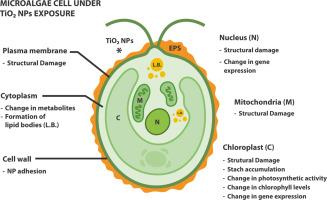二氧化钛纳米颗粒在微藻中的毒性研究进展综述
IF 4.3
2区 环境科学与生态学
Q1 MARINE & FRESHWATER BIOLOGY
引用次数: 0
摘要
二氧化钛(TiO₂)纳米颗粒(NPs)广泛应用于各个工业和研究领域,其潜在的环境污染物引起了越来越多的关注。本研究对TiO₂NPs对微藻的毒性进行了系统的综述,提供了当前研究结果的关键综合,并确定了指导未来研究的关键空白。分析表明,与生长抑制分析相关的许多变量(如NPs特性和实验条件)实质上影响毒性结果,使研究之间的直接比较复杂化。tio2nps毒性的主要机制是氧化应激的产生,主要由其光催化活性驱动。此外,与较大颗粒或金红石相为主的颗粒相比,较小的NPs和锐钛矿比例较高的NPs表现出明显更大的毒性。这些发现突出了对标准化方法和实验方案详细报告的迫切需要。未来的研究应仔细考虑每种分析方法的局限性,特别是关于NPs引起的潜在干扰,并确保所选择的方法与毒性评估的预期生态相关性相一致。本文章由计算机程序翻译,如有差异,请以英文原文为准。

The currently knowledge on toxicity of TiO2 nanoparticles in microalgae: A systematic review
Titanium dioxide (TiO₂) nanoparticles (NPs) are widely applied across various industries and research fields, raising growing concerns regarding their potential as environmental pollutants. This work presents a systematic review of the toxicity of TiO₂ NPs to microalgae, providing a critical synthesis of current findings and identifying key gaps to guide future research. The analysis reveals that numerous variables associated with growth inhibition assays—such as NPs characteristics and experimental conditions—substantially influence toxicity outcomes, complicating direct comparisons across studies. The primary mechanism underlying TiO₂ NPs toxicity is the generation of oxidative stress, mainly driven by their photocatalytic activity. Furthermore, smaller NPs and those with a higher proportion of anatase exhibit markedly greater toxicity compared to larger particles or those dominated by the rutile phase. These findings highlight the urgent need for standardized methodologies and detailed reporting of experimental protocols. Future studies should carefully consider the limitations of each analytical approach, particularly regarding potential interferences caused by NPs, and ensure that the selected methods align with the intended ecological relevance of the toxicity assessment.
求助全文
通过发布文献求助,成功后即可免费获取论文全文。
去求助
来源期刊

Aquatic Toxicology
环境科学-毒理学
CiteScore
7.10
自引率
4.40%
发文量
250
审稿时长
56 days
期刊介绍:
Aquatic Toxicology publishes significant contributions that increase the understanding of the impact of harmful substances (including natural and synthetic chemicals) on aquatic organisms and ecosystems.
Aquatic Toxicology considers both laboratory and field studies with a focus on marine/ freshwater environments. We strive to attract high quality original scientific papers, critical reviews and expert opinion papers in the following areas: Effects of harmful substances on molecular, cellular, sub-organismal, organismal, population, community, and ecosystem level; Toxic Mechanisms; Genetic disturbances, transgenerational effects, behavioral and adaptive responses; Impacts of harmful substances on structure, function of and services provided by aquatic ecosystems; Mixture toxicity assessment; Statistical approaches to predict exposure to and hazards of contaminants
The journal also considers manuscripts in other areas, such as the development of innovative concepts, approaches, and methodologies, which promote the wider application of toxicological datasets to the protection of aquatic environments and inform ecological risk assessments and decision making by relevant authorities.
 求助内容:
求助内容: 应助结果提醒方式:
应助结果提醒方式:


